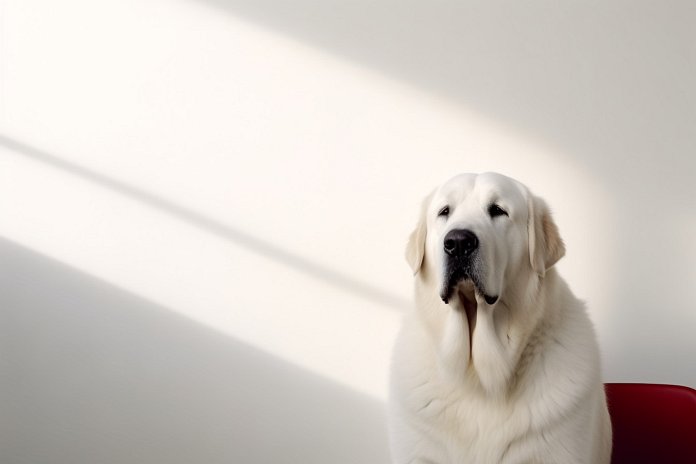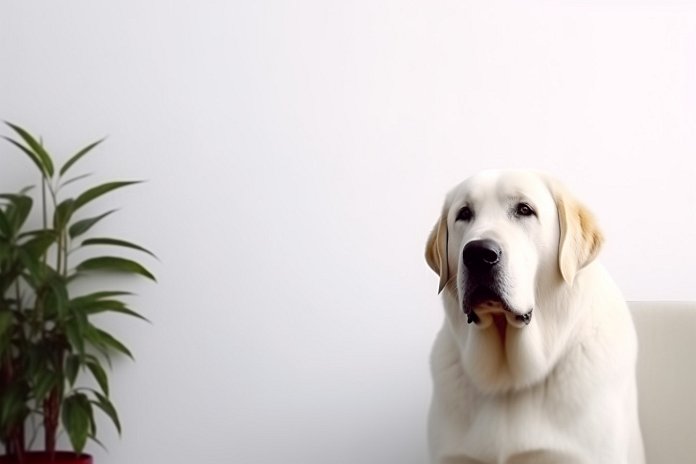
The Anatolian Pyrenees is a mix of the Great Pyrenees and the Anatolian Shepherd. This breed is known for its excellent protective instincts, making it a great choice for both families and animals. Both parent breeds have a history of being used as livestock guards. Despite their large size, the Anatolian Pyrenees is a gentle giant that gets along well with kids.
The Great Pyrenees originates from the Asian Pyrenees Mountains, while the Anatolian Shepherd comes from Turkey. Anatolian Pyrenees dogs are typically cream in color, with some brown or black patterns. One thing to note is that they shed more than average, which can make them appear high-maintenance at times.
Below, we look at Anatolian Pyrenees dog breed, its history, personality, pros and cons of owning an Anatolian Pyrenees, characteristics, and must-see facts. We will also examine how to care for this breed and much more. Prepare for a tail-wagging adventure into the world of Anatolian Pyreneess!
| Dog Breed | Anatolian Pyrenees |
| Size | Large |
| Weight | 80-120 lbs (average) |
| Height | 29-32″ (average) |
| Location | United States |
| Ancestry | Anatolian Shepherd, Great Pyrenees |
| Date of Origin | Unknown |
| Group | Companion, Herding |
| Life Expectancy | 10-12 years |
| Price | $500 – $600 |
| Family | Canidae |
| Scientific Name | Canis Lupus Familiaris |
📖 Breed History
The Anatolian Shepherd is originally from Anatolia, Turkey, and is so highly regarded that it has even been featured on a postage stamp. This breed has been present in America since the 1970s, where some people use them to protect livestock while others rely on them as watchful guardians.
On the other hand, the Great Pyrenees is known for its calm temperament and can adapt to apartment living, although it thrives in a home with a spacious yard where it can freely roam and channel its natural energy. Originating from Asia Minor, this breed was initially bred to assist sheep herders, but it gained fame when Louis XIV of France acquired a Great Pyrenees and declared it the Royal Dog of France. The Great Pyrenees made its way to the United States before World War II.
The Anatolian Pyrenees is a gentle giant that is excellent with children. This breed is a result of mixing the Anatolian Shepherd and the Great Pyrenees due to their similar traits as exceptional shepherd dogs. Typically, owners of this mixed breed tend to have farms and utilize these hybrid dogs to protect their livestock.

🐕 Anatolian Pyrenees Appearance
The Anatolian Pyrenees is a hybrid of two genetically fairly related breeds. The Anatolian Shepherd has a short coat with some longer hair around the ears, legs, and tail, whereas the Great Pyrenees is normally white or cream-colored with long hair. The Anatolian Shepherd typically has a blend of fawn, white, pinto, or brindle coloring. He frequently sports a black “mask” marker. The Anatolian Pyrenees may have a variety of colors, but they always have hair that is at least medium length. This garment is not waterproof.
| 👀 Eye Color | Varies |
| 🐽 Nose Color | N/A |
| 🐕 Coat Color | Ranges |
⚡ Fun Fact: Anatolian Pyrenees dogs need for social interaction is average. This breed likes being around people or other animals, but they don’t mind being left alone for a few hours either.
🐶 Traits & Temperament of Anatolian Pyrenees
The Great Pyrenees is an extremely “mellow” dog who is able to adjust to any circumstance. He is kind, dependable, and kind. The Anatolian Shepherd guards his family fiercely. He has a sharp mind and occasionally displays dominance. You may anticipate a blend of both characters in the Anatolian Pyrenees. Both are fantastic with kids, but the Anatolian Pyrenees need early socialization to become acclimated to kids, different animals, and a diversity of people. However, they are not suitable canines for inexperienced dog owners. The Anatolian Pyrenees need to be trained with patience.
🤝 Are Anatolian Pyreneess Friendly or Aggressive?
Anatolian Pyrenees dogs tend to get along well with other pets, but they are not the most welcoming towards strangers. They have an average level of friendliness towards children and cats, and they are not known to be particularly friendly towards other dogs. Therefore, if you are looking to have multiple dogs or participate in dog meetups, the Anatolian Pyrenees may not be the best breed for you. However, they generally do well with elderly people.
This breed is known for being:
- Independent
- Intelligent
- Confident
- Affectionate
- Patient
- Gentle
- Strong
- Willed
- Bold
- Proud
- Steady
- Fearless
🐩 Anatolian Pyrenees Care & Maintenance
Sadly, the Anatolian Pyrenees constantly lose snow. He could require regular brushing to keep a healthy coat. It’s probable that the Anatolian Pyrenees will inherit the parent breed’s inherent cleanliness as the Anatolian Shepherd is the parent breed. The teeth of your Anatolian Pyrenees dog should be brushed at least three times each week; however, regular brushing is recommended to stave off gum disease. Every other week, trim your dog’s nails. As a general guideline, you should trim your dog’s nails when you hear them clicking on the floor. Great Pyrenees and Anatolian Shepherds frequently have cataract, dilated cardiomyopathy, and epilepsy. To prevent exorbitant veterinarian care costs, get pet health insurance right now. Presented to you by Wag Pet Insurance! Pet owners may compare insurance packages from top providers like Figo and Spot using Wellness. With only a few clicks, find your pet’s “pawfect” plan!
Anatolian Pyrenees dogs are known for shedding a lot of hair. This is a normal part of their hair growth cycle, so be prepared to do daily vacuum cleaning to keep up with it. The amount and frequency of shedding can vary depending on the dog’s health and the specific breed they belong to. In terms of bathing, it is recommended to give them a bath every 3-4 weeks.
🍖 Food: We recommend few cups daily, costing you about $0.49 – $1.49 daily, or around $30.00 a month.
🐾 Exercise: Anatolian Pyrenees dogs have an average exercise need. This breed is satisfied with short walks every weekday and a long ones on weekends.
This dog breed requires to be walked for roughly few miles per week, which equates to about 15 – 35 minutes of physical activity daily. This consistent moderate exercise regimen will help maintain their physical wellness and significantly contribute to their mental stimulation. Consciously setting aside this time for your furry friend can dramatically enhance their life quality, helping them stay energetic, healthy, and mentally alert.
Did you know: Anatolian Pyrenees dogs have a higher energy level than other dog breeds. If you want a dog for snuggling on the couch, this breed isn’t the perfect choice for you.
❤️🩹 Anatolian Pyrenees Health & Issues
Some of the major concerns for Anatolian Pyrenees Dog Breed can be:
- Demodectic Mange
- Hip Dysplasia
While minor concerns include:
- Entropion
🤧 Important: Is Anatolian Pyrenees hypoallergenic? No.
✨ Bonus: Check out cool, creative, and funny names for Anatolian Pyrenees.
⚡ Anatolian Pyrenees Dog Breed Facts
What makes the Anatolian Pyrenees a great choice for families with young children?
The Anatolian Pyrenees is a great choice for families with young children because they are gentle and great with kids.
Is the Anatolian Pyrenees breed considered a suitable breed for apartment living?
The Anatolian Pyrenees is not considered a suitable breed for apartment living due to their size and exercise needs.
How much exercise does a Anatolian Pyrenees require compared to other breeds?
The Anatolian Pyrenees requires a moderate amount of exercise compared to other breeds. Daily walks and playtime are recommended.
Is the Anatolian Pyrenees breed known for being good with other pets?
The Anatolian Pyrenees breed is known to be good with other pets, but early socialization is important.
What are other low-maintenance dog breeds similar to the Anatolian Pyrenees?
Other low-maintenance dog breeds similar to the Anatolian Pyrenees include the Great Pyrenees and the Anatolian Shepherd.
What are the common health issues that Anatolian Pyreneess are prone to?
Common health issues that Anatolian Pyrenees are prone to include hip dysplasia, bloat, and obesity.
Are Anatolian Pyreneess known to be easy to train compared to other breeds?
Anatolian Pyrenees can be moderately easy to train, but patience is required due to their dominant nature.
Are Anatolian Pyreneess more prone to separation anxiety compared to other breeds?
Anatolian Pyrenees can be prone to separation anxiety, so proper training and socialization from a young age is important.
Are there any dog breeds similar to the Anatolian Pyrenees that are suitable for people with allergies?
Some dog breeds similar to the Anatolian Pyrenees that are suitable for people with allergies include the Poodle and the Bichon Frise.
What sizes of dogs similar to the Anatolian Pyrenees are best for individuals or families with limited space?
Smaller-sized dogs similar to the Anatolian Pyrenees, such as the Miniature Schnauzer or the Shih Tzu, are best for individuals or families with limited space.
Is the Anatolian Pyrenees breed known to be good with children with special needs?
The Anatolian Pyrenees breed is known to be good with children, including those with special needs, but supervision and proper socialization are important.
How does the grooming and shedding needs of the Anatolian Pyrenees?
The grooming and shedding needs of the Anatolian Pyrenees are considered high-maintenance due to their above-average shedding. Regular brushing and grooming are necessary.
We use reliable and publicly available data and resources such as AKC and American Canine Registry to ensure that Anatolian Pyrenees dog breed information is accurate and up to date. If you spot an error, please don’t hesitate to bring it to our attention.